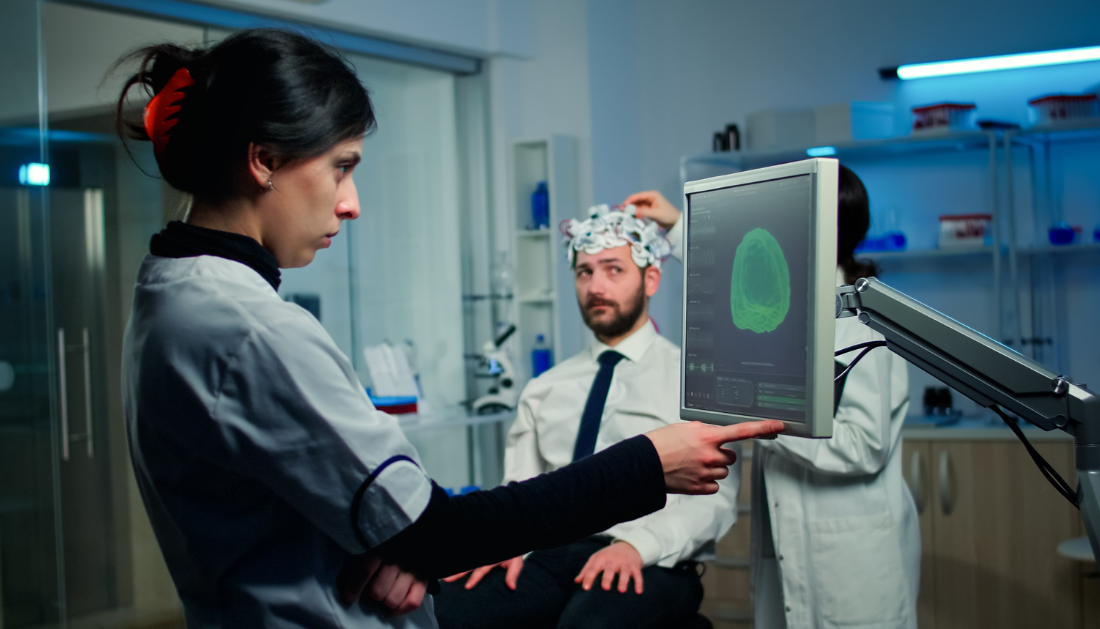

A wearable ultrasonic patch created by engineers at the University of California, San Diego has the potential to provide continuous, non-invasive monitoring of cerebral blood flow. For the first time in wearable technology, the soft, flexible patch may be worn comfortably on the temple to offer three-dimensional data on cerebral blood flow.
The researchers published their novel technology in Nature under the direction of Sheng Xu, a professor in the UC San Diego Jacobs School of Engineering’s Aiiso Yufeng Li Family Department of Chemical and Nano Engineering.
Transcranial Doppler ultrasonography, the current clinical standard, is much inferior to the wearable ultrasound patch. An ultrasound probe must be held against the patient’s head by a qualified technician in order to use this approach. There are drawbacks to the procedure, though. Because it is operator-dependent, the operator’s skill level will determine how accurate the measurement is. Moreover, it is not feasible for continuous usage.
Xu’s group created a tool that gets around these obstacles. Throughout a patient’s hospital stay, their wearable ultrasonography patch provides a hands-free, reliable, and comfortable solution that can be worn continually.
In Xu’s lab, Sai Zhou, a Ph.D. candidate in materials science and engineering, is co-first author of the work. “The continuous monitoring capability of the patch addresses a critical gap in current clinical practices,” Zhou said. Cerebral blood flow is typically measured at specified periods of the day, and such readings may not accurately reflect what occurs during the remainder of the day. Unnoticed variations may occur in between measurements. This gadget may provide information that is essential for prompt intervention if a patient is about to suffer a stroke in the middle of the night.”
According to Geonho Park, a Ph.D. student in Xu’s lab studying chemical and nanoengineering and another co-first author of this work, patients undergoing and recuperating from brain surgery can also benefit from this technique.
The patch is made of silicone elastomer and has multiple layers of flexible electronics embedded in it. It is about the size of a postage stamp. One layer is made up of a collection of tiny piezoelectric transducers that, when electrically activated, generate ultrasonic waves and receive waves that are reflected from the brain. A copper mesh layer consisting of spring-shaped wires is another essential element that improves signal quality by reducing interference from the wearer’s body and surroundings. Elastic electrodes make up the remaining layers.
The patch is wired to a computer and power source in order to function. The researchers included ultrafast ultrasound imaging into the device in order to accomplish 3D monitoring. Ultrafast imaging records thousands of images per second, in contrast to normal ultrasound’s 30 photos per second. Because of the heavy reflection of the skull, the piezoelectric transducers in the patch would ordinarily have poor signal intensity, making this fast frame rate essential for obtaining reliable data.
After that, the data are post-processed using unique algorithms to recreate 3D details like the major arteries of the brain’s size, angle, and location.
“The cerebral vasculature is a multibranched, intricate system of vessels. A second co-first author of this work and a Ph.D. candidate in materials science and engineering at Xu’s group, Xinyi Yang, stated, “To get the full picture and obtain more accurate measurements, you need a device capable of capturing this three-dimensional information.”
The ability of the patch to assess blood flow velocities—peak systolic, mean flow, and end diastolic velocities—in the primary arteries supplying the brain was examined in this study on 36 healthy participants. Participants performed blood-flow-affecting exercises like grasping with their hands, holding their breath, and reading. The measures taken with the patch and a traditional ultrasonography probe agreed quite well.
The patch will then be tested on individuals with neurological disorders that affect cerebral blood flow by the researchers in partnership with medical professionals at UC San Diego School of Medicine. Xu is a co-founder of Softsonics, a startup firm aimed at commercializing this technology.
For more information: Transcranial volumetric imaging using a conformal ultrasound patch, Nature, https://dx.doi.org/10.1038/s41586-024-07381-5
more recommended stories
 Gestational Diabetes Risk Identified by Blood Metabolites
Gestational Diabetes Risk Identified by Blood MetabolitesKey Takeaways (Quick Summary for Clinicians).
 Phage Therapy Study Reveals RNA-Based Infection Control
Phage Therapy Study Reveals RNA-Based Infection ControlKey Takeaways (Quick Summary) Researchers uncovered.
 Pelvic Floor Disorders: Treatable Yet Often Ignored
Pelvic Floor Disorders: Treatable Yet Often IgnoredKey Takeaways (Quick Summary) Pelvic floor.
 Circadian Control of Neutrophils in Myocardial Infarction
Circadian Control of Neutrophils in Myocardial InfarctionKey Takeaways for HCPs Neutrophil activity.
 E-Cigarette Use and Heart Attack Risk in Former Smokers
E-Cigarette Use and Heart Attack Risk in Former SmokersKey Takeaways for Clinicians and Nurses.
 Ultramarathon Physiology: What HCPs Should Know?
Ultramarathon Physiology: What HCPs Should Know?Ultramarathon Metabolism: What Happens to the.
 High-Intensity Training and Oxidative Stress Insights
High-Intensity Training and Oxidative Stress InsightsNew Evidence Linking High-Intensity Training and.
 Sterilized Fermented Beverage for Obesity: New Evidence
Sterilized Fermented Beverage for Obesity: New EvidenceEarly Insights Into a Sterilized Fermented.
 Cardiovascular Risk and Sudden Cardiac Death in Diabetes
Cardiovascular Risk and Sudden Cardiac Death in DiabetesRising Sudden Cardiac Death (SCD) Risk.
 Perinatal Mental Health Challenges Highlighted in New Study
Perinatal Mental Health Challenges Highlighted in New StudyMental Health Challenges in New Parents:.

Leave a Comment